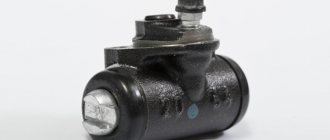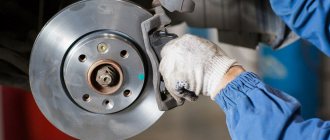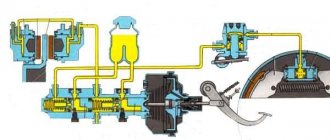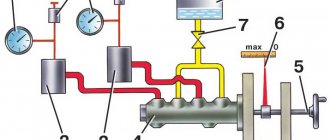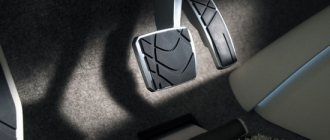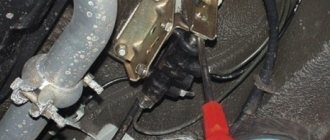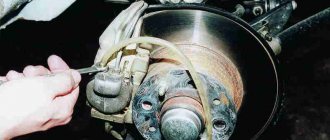Such a Soviet car as the VAZ-2106 has been produced since 1975. In 2005, the conveyor was stopped. The car became a real legend and an attribute of the Soviet automotive world. He was a favorite of many citizens of the USSR, although, like any car of that time, the car could not boast of a good braking system. This VAZ 2106 system leaves much to be desired.
Diagram of the brake system of a VAZ 2106 car. 1 - brake disc; 2 — brake pedal; 3 - vacuum booster; 4 — master cylinder for hydraulic brakes; 5 — pipeline of the front brake drive circuit; 6 — front brake protective cover; 7 — front brake caliper; 8 - vacuum pipeline; 9 — master cylinder reservoir; 10 — parking brake lever button; 11 — parking brake drive lever; 12 — lever latch rod; 13 — lever latch; 14 — bracket for the parking brake drive lever; 15 — return lever; 16 — pipeline of the rear brake drive circuit; 17 — flange of the rear end of the cable sheath; 18 — rear brake wheel cylinder; 19 — rear brake pressure regulator; 20 — pressure regulator drive lever; 21 — brake pads; 22 — lever for manual drive of the pads; 23 — rod of the pressure regulator drive lever; 24 — bracket for fastening the front end of the cable sheath; 25 — rear cable; 26 - lock nut; 27 — adjusting nut; 28 — bushing; 29 — rear cable guide; 30 — guide roller; 31 — front cable; 32 — parking brake warning lamp switch stop; 33 - brake light switch
Preparation
The work is best done on a flat, paved area - most typical garages will be a bit cramped. Find a suitable support in advance - hanging a car on a standard jack is dangerous, especially considering the state of the jacking sockets on cars, the youngest of which is almost ten years old. Also for work you will need:
- narrow nose pliers;
- a thin drift (at worst - a piece of 4 mm electrode or a thick nail);
- metal brush;
- powerful flat screwdriver;
- rubber bulb or large syringe.
First, you need to pump out the old brake fluid from the reservoir - when the working pistons are recessed, it can overflow, and replacing it with fresh one would be quite reasonable. It is worth placing stops under the wheels and, having removed the tightened bolts, hang the car, place a support under the threshold and release it down.
Problems when braking
The parking brake is a mechanical lever-type device with a cable drive. In this case, braking is carried out only by the rear wheels. These brakes include a brake lever, cable, pads. All brake system problems can be divided into several types. Moreover, each malfunction has a list of specific causes and methods for eliminating them. Problems that arise during the operation of the braking system usually have the following manifestations:
- braking is not fast and effective enough;
- incorrect and untimely braking;
- during braking, the car drifts to the side;
- jamming of the cable when turning the handbrake on and off.
The braking process may not be fast or effective enough if brake fluid leaks. This can happen in the area where the VAZ brake cylinders are located. To fix this problem, you need to remove the broken parts and install new ones. It will be necessary to clean and dry all the pads, drums of the VAZ 2106 brake system, and the hydraulic brake drive.
Problems with braking can arise due to the accumulation of air in the depths of the VAZ system itself. If you get rid of it, the car will work perfectly. Malfunction of hoses leads to disastrous consequences, so they need to be changed on time. Rubber seals located in the brake system affect the operation of the machine, so they require timely replacement.
1 – cap; 2 – clamp; 3 – wheel mounting bolt; 4 – brake drum; 5 – hub; 6 – axle; 7 – brake shield; 8 – brake pad; 9 – pressure spring; 10 – emphasis; 11 – the tip of the spacer bar is long; 12 – tension spring (long); 13 – dirt-proof cover; 14 – cylinder; 15 – piston; 16 – cuff; 17 – thrust ring; 18 – air release valve; 19 – valve cap; 20 – flexible hose; 21 – lock washer; 22 – axis; 23 – adjusting nut; 24 – the tip of the spacer bar is short; 25 – expansion lever; 26 – cable end; 27 – cable spring; 28 – cable; 29 – tension spring (short); 30 – split washer; A – threaded holes for removing the drum
Another common malfunction of the brake system is incorrect and untimely braking. This can happen when the car engine is still running, and the VAZ system begins to slow down. It may occur due to the fact that the vacuum brake booster of the VAZ begins to malfunction. If its cover or seal wears out, the part is poorly secured.
If such a malfunction occurs, you need to completely replace the entire vacuum brake booster of the VAZ 2106. The lubricant may have been used quickly, so you need to add it to the vacuum seal, having first unscrewed the cap. The wheels of the vehicle may not fully release the brakes. This happens because there is no travel in the brake pedal. This in turn is caused by an incorrect position of the brake light.
To remove this malfunction, it is enough to adjust the switch correctly. It is necessary to monitor the protrusion of the bolt in the brake booster. The protrusion itself should be approximately 1.25-0.25 mm. But if the vacuum booster has stuck valves due to swollen seals and diaphragms, then it needs to be completely replaced.
Damage and strange sounds
If any units are damaged during the occurrence of the problem, they must be replaced with new ones. If the brake disc produces runout with an increase of 0.15 mm, then it needs to be ground, and if it is already less than 8-9 mm thick, then it’s time to replace it. The next problem with the braking system is situations where the car pulls too far to the side when braking. This occurs in cases where there may be a leak from the cylinder.
To prevent brake fluid from leaking, you need to change the seals. To fully check the circuit requires bleeding. In this situation, the pistons themselves from the cylinder may jam. They need to be checked on time. Make sure the parts are intact. If the brake system units are clogged, it should be cleaned. It is imperative to check all drums, linings, discs, as they can become clogged. All parts of the system require timely cleaning.
If the regulator responsible for the pressure level is not adjusted correctly, then you need to adjust it and set it correctly. If its diagnostics and adjustment show that it is out of order, the unit needs to be replaced. If the cable is damaged, the handbrake may stick, which will affect the efficient operation of the entire vehicle, so the cable must be replaced. You need to completely replace the VAZ handbrake if the entire mechanism is damaged and the handbrake fails.
With increased pressure on the brake pedal, there may be problems with air filters, booster valves, hoses and the seal itself. To eliminate all problems, you need to check these units, clean them, and if they break down completely, parts need to be replaced.
If you hear sounds (creaking) in the brakes, this may be caused by weakening of any parts, springs, wear, breakage, contamination, or too much beating of the brake disc. All these elements need to be checked, tightened, cleaned or replaced. Monitoring the operation of the braking system allows you to study the design and ensure safe operation of the vehicle.
Replacing the front brake pads of a VAZ 2106
Always replace brake pads in pairs, on a vehicle with the front wheels suspended, either jacked up and placed on supports or on special lifts. If the thickness of the linings of the old pads has reached a thickness of 1.5 mm, then they must be replaced with new ones.
To carry out repair work we will need: a wrench for wheel bolts, a mounting blade, a punch, a caliper, pliers, a file and a hammer.
- Remove the front wheel and clean the brake mechanism from dirt with a metal brush, especially clean the pad mounting pins well.
- Remove the locking pins from the fingers and pull out the fingers; partial removal of the fingers from the cylinders is allowed. If your fingers are dry and do not move well, use a liquid like WD-40.
- Remove the pad pressure springs and remove the brake pads.
When removing the brake pads, do not press the brake pedal to avoid pushing the brake pistons out of the cylinders.
- Wipe the inside of the wheel cylinders with a clean cloth, conduct a visual inspection and check the condition of the dust caps, which should not show cracks or other signs of aging, and replace them with new ones if necessary.
- Using a caliper, measure the thickness of the brake disc; if the disc already has a groove in the form of a flange on both sides, then it must be removed with a file in three places and it is in these places that the thickness must be measured. The thickness of the disc must be at least 9mm. If the thickness is less or varies in different places of the brake disc, then the disc must be replaced with a new one.
- Next, using a mounting blade, through the spacer, resting the mounting against the brake disc, you need to press the brake pistons into the cylinders one by one. When the pistons are pressed in, the brake fluid level in the reservoir rises, so if the brake fluid level is at maximum, to avoid overflow, pump out the fluid a little.
- Install new pads in the reverse order of removal. After that, press the brake pedal several times so that the pistons return to their place.
- Replace the brake pads on the other wheel.
At this point, the repair of replacing the brake pads of the VAZ 2106 is completed. After replacing the pads, do not rush to drive out onto a busy street, since under heavy braking you will quite possibly notice a significant decrease in the effectiveness of the brakes, which is caused by the fact that the brake disc also has wear and tear and, accordingly, the new pads do not fit tightly to it, so run it in before driving out. and grind the new pads to the disc, to do this, simply accelerate and slow down slightly and do this several times until braking efficiency is restored.
Summary
The braking system is the basis for vehicle safety. If the slightest problem occurs in its operation, you must immediately look for the problem and fix the problem. In fact, there are not so many reasons. In addition, everything can be much simpler - for example, a knock in the wheel when braking occurs due to a loose caliper mounting bolt.
Yesterday, after driving without music, well, I got fed up, and heard an interesting knock. When I press the brake pedal (I just touched it, one might say), a single metallic (it seems to me) knock occurs. It was not possible to localize it, either on the right front or behind. And sometimes there is a knock, sometimes there isn’t. For example, I’m rolling at 40, I touch the brake (that is, I’m not braking to the floor), the brake light comes on and this knock sounds. I release the pedal, press - silence, stop, press in place - silence, move off, brake - silence, move off, drive 20-50 meters, press - knock. The pedal doesn't respond, but it infuriates me when something goes wrong.
Experts, attention to the question, what is knocking? Stub racks? Caliper? pads?
When I changed the pads, I lubricated the guides, but then I lubricated them and thought why I was doing this, since part of the guide is in the open air. And the thought came to me now that maybe the dirt has stuck and is wedging?
The appearance of a knocking sound when you press the brake pedal is not common, but it still occurs. At the same time, diagnosing the cause of the knock is quite difficult.
Let's figure out where this knocking comes from and how to solve this problem.
The braking system is one of the main ones ensuring traffic safety. This is what slows the car down to a stop.
The most widely used system on cars is a hydraulic drive system, when the driver’s force is transmitted through the working fluid to the brake mechanisms installed on the wheel hubs.
As for the mechanisms themselves, there are two types of them used on cars - now disc mechanisms in which pads, the elements that perform deceleration, interact with a disc mounted on the wheel hub are becoming increasingly widespread.
Previously, drum mechanisms in which the shoes were placed inside the drum were more common in use; the deceleration in such mechanisms was carried out by decompressing the shoes, as a result of which they were pressed against the inner surface of the drum.
But they did not completely abandon the use of drum mechanisms, since they have a well-implemented parking brake system.
Therefore, many cars are equipped with disc mechanisms at the front and drum mechanisms at the rear.
Maintenance of a hydraulically driven system comes down to periodic replacement of the pads, since they are worn out as a result of interaction.
Therefore, checking the condition of discs and drums is necessary.
The condition of the pipelines in the drive is checked, a visual inspection is performed for leaks, and the liquid level is monitored.
Often, after repair work, it is necessary to bleed the brake drive to remove air from the pipelines, because its presence can affect the performance of the system.
Since the brake system does not include a large number of elements, it is considered to be quite reliable and should not cause problems with proper care and maintenance.
But it is not always the case. Even in such a seemingly simple system, problems can arise.
One of the most common problems is the appearance of a knocking sound when pressing the pedal.
About grooving brake drums
As mentioned above, some defects that arose during the operation of brake drums can be eliminated using the so-called groove. It should be said right away that it is not possible to sharpen a drum yourself in a garage. Because for this, firstly, you need a lathe, and secondly, you need the skill of working on this machine, and a serious skill at that. A novice driver can hardly boast of having a machine in his garage and the corresponding skills. Therefore, he has only one option left: to seek help from a qualified turner.
For high-quality drum turning, you can’t do without a lathe.
So what is a brake drum groove? It usually consists of three stages:
- preparatory stage. The turner removes about half a millimeter of metal from the inner walls of the drum. After this, the machine is turned off, and the drum is carefully inspected for internal defects. The preparatory stage allows you to determine the general level of wear of the drum and the feasibility of further work. Sometimes, after the preparatory stage, it turns out that the groove is useless due to severe wear, and it is easier to replace the drum than to grind it;
- main stage. If, after preliminary processing, it turns out that the drum is not very worn, then the main stage of turning begins, during which the turner smoothes and grinds all small cracks and grooves. During this work, about 0.3 mm of metal will be removed from the inner walls of the drum;
- The final stage. At this stage, the sanded surface is polished using a special paste. This procedure eliminates even the smallest defects that are not visible to the naked eye, and the surface becomes perfectly smooth.
It should be noted here that the groove will help get rid of internal defects on the drum, but it will be useless if the geometry of the drum is broken. For example, the drum was warped due to an impact or due to severe overheating. If the drum is cast iron, then it will have to be changed, since it is extremely difficult to straighten brittle cast iron using metalworking tools. If the drum on the “seven” is light alloy, then you can try to straighten it. And only after that start grooving.
Let's sum it up
Tuning a car's brake system is a very responsible job. Unsuccessful modernization of the appearance of a vehicle or its interior will only affect the unpresentable appearance of the car. A mistake in upgrading your brake system could cost you or other road users your life. Take responsibility for modifications that affect the vehicle's braking system. Buy only certified high-quality spare parts from reputable manufacturers. Proceed to independently improve the brake system of your car only if you are completely confident in your abilities and capabilities.
Sources used:
- https://vz06-up.ru/ts/tormoznaya-sistema-vaz-2106.html
- https://automn.ru/vaz-2106/vaz-14711-10.m_id-770.m_id2-1436.html
- https://avtovx.ru/tormoznaya-sistema/tormoznaya-sistema-vaz-2106-204/
- https://remam.ru/tune/kak-uluchshit-tormoza-na-vaz-2106.html
When product replacement is required
Both the front and rear wheels are characterized by the use of 4 brake pads to ensure effective braking. Only in design these products are very different, although the principle of operation is similar.
The rear pads of the VAZ 2107 are presented in the form of an arched steel structure, on the outer part of which a friction layer is applied. It is due to the friction of this layer against the inside of the drum that the car stops. If you do not replace the brake elements in a timely manner, this will be fraught with the development of unpredictable consequences, because the most important thing for any car is the serviceability of the braking system.
It will not be possible to determine this fact without removing the wheel and dismantling the drum. But this is one of the main ways to determine whether the brake system is faulty. There is a second option, which is more convenient and does not require dismantling the rear wheel. To do this, you need to listen for signs of squeaking of the rear wheels, as well as grinding and lack of braking effect, but this can lead to damage to the drum itself. You can squeeze the handbrake while standing on a slope and check that it is working correctly. Of course, the cable on the handbrake may become loose, but if you tighten it and still have no effect, then it’s time to start replacing the pads. If the rear brakes are not functioning, then it is time to change the pads. It is recommended to change them as a set on both rear wheels, since they are often worn out at the same time. What is the process of replacing rear brake pads on a VAZ 2107 will be determined further.
On a note! All four pads on the rear wheels need to be replaced at the same time, even if the friction linings are worn unevenly.
Instructions for replacing rear pads
At the beginning of the work, it should be noted that the handbrake must initially be lowered to its lowest position. This will allow you to dismantle the brake drum and thereby get to the worn parts. To begin replacing the brake pads of a VAZ 2107, it is necessary to remove the rear wheel:
- There is a drum behind the wheel, which also needs to be removed. There are no problems with this, so we move on.
- After removing the drum, it is necessary to inspect the worn pads. If the thickness of the friction lining exceeds 1.5 mm, then there is no need to replace the products. Before carrying out further work, it is necessary to clean the mechanism from dirt and dust. To do this, you can use a brush or cloth.
- If the products need to be replaced, then you need to take a screwdriver and then remove first the upper, then the lower connecting springs. If you can’t dismantle it with a screwdriver, then you should use pliers. The photo below shows the springs that should be removed.
- Next, you need to remove the clamps, which consist of a rod, a washer and a spring. These washers must be rotated 90 degrees to remove them through the slots. This is what the washers that hold the pads look like.
- Similar procedures are carried out with the second block.
- After removing the springs and clamps, the pads are removed independently.
- The parking brake locking pin is straightened. The photo below shows the location of the locking pin. Now you need to unscrew the parking brake lever. This can be done using pliers. After this, the washer is removed, then the lever.
- During the dismantling process, you will have a question, what to do with the parking brake tip? It must be disconnected from the product and then left hanging.
- If necessary, it is recommended to replace all parking brake parts that were removed from the old product with new ones.
The rear brake pads on the VAZ 2107 should be installed in the reverse order of removal. Before installation, remember to bring the brake cylinder pistons as close as possible. Despite their simple design, installing them is much more difficult than the front ones.
But having completed the procedure once, all subsequent repairs will be much easier for you.
The cost of new pads starts from 800 rubles per set, but it is important to purchase high-quality products, and not Chinese “consumer goods”. Not only the service life of the products, but also the braking of the car will depend on this. This completes the replacement procedure, if you have any questions, be sure to ask them
This completes the replacement procedure; if you have any questions, be sure to ask them.
Instructions for replacing rear pads
Raise the rear of the car with a jack from either side. Install wheel chocks under the front wheels. Remove the wheel by unscrewing the mounting bolts and lockers. Now you need to remove the drum from its seat. As a rule, during the operation of the car, it settles and “sticks,” which complicates the dismantling process. It is recommended to use a hammer to give several gentle blows to the surface of the drum between the studs. After removing the drum, it is necessary to clean the brake mechanism itself and the seat from dust and dirt with a brush. Check the drum for wear
If there are severe chips, cracks or burrs, replace with a new one. Remove the upper tension spring using a screwdriver or pliers. Press the support spring plate with pliers. Turn the plate ¼ turn. Remove the support strut of the second block in the same way. Move the brake pads apart and remove the clearance adjuster. Remove the lower tension spring by hand. Now you need to pay attention to the handbrake mechanism, which is located on the rear block. It needs to be dismantled. To do this, you need to remove the locking ring and remove the pin using pliers. Check the condition of the brake pads
If necessary, replace with new ones. After replacing the pads, it is necessary to adjust the gap between the pads and the drum itself. To do this, you need to remove the rubber plug from the inside of the dirt shield and use a flat-head screwdriver to turn the regulator gear. The wheel rotates only in one direction to spread the pads. It is necessary to achieve light contact between the pads and the drum. Before assembling all parts of the brake drum system, it is necessary to wash all parts in gasoline, disassemble the clearance adjuster and lubricate it with graphite or silicone grease. Assembly is carried out in the reverse order of dismantling. Place the vehicle on the ground and secure the wheel mounting bolts. Repeat the procedure with the second wheel.
To do this, you need to remove the locking ring and remove the pin using pliers. Check the condition of the brake pads. If necessary, replace with new ones. After replacing the pads, it is necessary to adjust the gap between the pads and the drum itself. To do this, you need to remove the rubber plug from the inside of the dirt shield and use a flat-head screwdriver to turn the regulator gear. The wheel rotates only in one direction to spread the pads. It is necessary to achieve light contact between the pads and the drum. Before assembling all parts of the brake drum system, it is necessary to wash all parts in gasoline, disassemble the clearance adjuster and lubricate it with graphite or silicone grease. Assembly is carried out in the reverse order of dismantling. Place the vehicle on the ground and secure the wheel mounting bolts. Repeat the procedure with the second wheel.
After replacing the brake pads on the drums, you need to drive to a quiet place and check the functionality and effectiveness of the pads. It is highly recommended that you replace any damaged or worn brake drum parts. Adjustment of the pads must be done once a year, or 15-20 thousand km. This is necessary for uniform wear of the rear pads and maintaining the braking efficiency of the rear wheels. It is recommended to perform this procedure in a lifting box, but if necessary, a jack with an inspection hole will do.
Pressure regulator
It is installed in the rear wheel drive and not only distributes fluid to the mechanisms, it also prevents possible skidding due to different forces on the mechanisms. This is done by limiting the supply of pressure to the mechanisms, depending on the position of the car body relative to the bridge.
The regulator is driven by a rod, one end of which is fixed to the rear axle, while it itself is fixed to the body. As the load on the rear axle increases, the body changes position relative to the axle; as a result, the rod puts pressure on the regulator piston, which adjusts the pressure supplied to the mechanisms.
Pads for VAZ 2106
Despite the fact that the model has long been discontinued, there are plenty of original spare parts on the car market. In addition to factory parts, a number of components manufactured by foreign companies are available for sale. Obviously, the price of domestic brake system elements will be cheaper than their foreign counterpart.
Brake pads must be replaced if the limiting friction lining thickness of 2.0 mm is reached. Below this norm, there is a high probability of deformation and splitting of the lining into pieces. Elements of the brake system must be immediately replaced if engine, transmission oil or antifreeze gets on the surface.The process of replacing pads is not complicated; every driver can do it, even without experience in servicing equipment.
Original
| vendor code | Price, rub.) | vendor code | Price, rub.) |
| 21013501090 “Cedar” | 450 | 21010350180083 | 470 |
| 21010350180082 | 470 | 21010-3501800-84 | 510 |
| 21010350180087 | 450 | 21010-350180085 | 470 |
Substitutes
| vendor code | Price, rub.) | vendor code | Price, rub.) |
| 0026400 TRW | 570 | 41062 | TRW |
| GDB140M ABS | 650 | ADB0281 | ABS |
| 98271307 Allied Nippon | 750 | Delphi 65139 | 780 |
| LP92/S | 800 | Delphi 0065139 | 780 |
| 98271307 Allied Nippon | 750 | Delphi 65139 | 780 |
| 98271307 Allied Nippon | 750 | Delphi 65139 | 780 |
| Allied Nippon | 65139 |
What rear brake pads can be installed on a VAZ 2106
The original rear brake pads are 3.5mm thick. With use, the friction lining wears out and is erased. When the thickness reaches 1.5 mm, the part must be replaced. Further operation of the machine is unsafe.
The process of replacing rear pads is as simple as replacing the front ones. Unless a handbrake cable is added, which should be removed. It is not necessary to have any special experience or skills. Please resort to the help of service station workers if you identify a large-scale breakdown that requires prompt intervention from professionals.
Original
| vendor code | Price, rub.) | vendor code | Price, rub.) |
| VIS 0021929 | 550 | VIS 0005937 | 570 |
| 68822 | 550 | 21010-350209002 | 570 |
| 2101-3502090 | 550 | START 12151 | 570 |
| 63276 | 570 | 21010-3502091 | 570 |
Substitutes
| vendor code | Price, rub.) | vendor code | Price, rub.) |
| Delphi 65140 | 850 | Finwhale 23593 | 800 |
| LS1219/S | 850 | VR311 | 800 |
| Bosch 17888 | 950 | TRW 26401 | 800 |
| 986487217 | 850 | GS8164 | 850 |
| HZTS 79927 | 800 | 2101-3502090 | 800 |
| Start 63275 | 800 | 21010-3502092 | 850 |
| MASTER SPORT 2103-3502093 | 850 | 030137-02332 | 800 |
The lists are presented for informational purposes. Before purchasing, be sure to consult with a specialist from a service center or auto store to determine the compatibility of the catalog article with the make/model of your car.
How to independently replace the front and rear pads on a VAZ 2106
Preparatory stage: a set of automotive tools, rags, new pads, liquid to remove layers of rust and corrosion.
Place the machine on a level platform. The option with an inspection hole or road overpass is excluded due to inefficiency; We jack up the front wheel with a hydraulic jack, remove it, having previously installed the wheel chocks; Use pliers to remove the guide pins
Please pay attention to the pressure springs; they may fly out during the work; Using a flat-tip screwdriver, press the slave cylinder into its original position. We widen the gaps to remove the brake pads; We remove worn pads, carry out preventive maintenance on the brake caliper, clean it from rust and deposits
If necessary, use a liquid like WD-40; Replace with new pads, assemble the structure in reverse order.
Subject to the above recommendations and the purchase of original spare parts, the service life of the brake system elements is 20 - 25 thousand km. mileage A moderate driving style and average ambient temperatures will increase the service life by 5 - 7 thousand km.
Problems when paying with bank cards
Sometimes difficulties may arise when paying with Visa/MasterCard bank cards. The most common of them:
- There is a restriction on the card for paying for online purchases
- A plastic card is not intended for making payments online.
- The plastic card is not activated for making payments online.
- There are not enough funds on the plastic card.
In order to solve these problems, you need to call or write to the technical support of the bank where you are served. Bank specialists will help you resolve them and make payments.
That's basically it. The entire process of paying for a book in PDF format on car repair on our website takes 1-2 minutes.
If you still have any questions, you can ask them using the feedback form, or write us an email at
Digital speedometer in the instrument panel of VAZ-2107
I have long dreamed of replacing the standard speedometer driven by a flexible cable on my Lada with a digital one (powered by a speed sensor), but after reviewing all the forums, using the Yandex, Google and other search engines, I realized that I couldn’t find such an article, especially a standard digital one for this There is no dashboard provided (the main injector was installed, the speed sensor was screwed into the box, but apparently there wasn’t enough strength to do the rest...
Yes, of course, there were radical articles with a complete replacement of the dashboard, including from the Volga, Tens, etc., but I just wanted to replace the speedometer, especially since the layout of the instruments suited me quite well (what can I say - classic).
Auto repair school – DIY car repair
Jun 14, 2022 VAZ 2101, VAZ 2102, VAZ 2105, VAZ 2106, VAZ 2107, Zhiguli, Classics by admin
Let's return to our immortal and beloved Classics! In this article we will look at the process of replacing the front brake hose on VAZ-2101, VAZ-2102, VAZ-2104, VAZ-2105, VAZ-2106, VAZ-2107, Classic cars. I hope that it will be useful to you and after reading it, you will be able (or will have information) on how to replace the front brake hoses yourself. I, in turn, will try to describe the replacement process in as much detail as possible and warn you about possible problems that may arise during operation.
Pay special attention to the list of necessary tools and the quality of purchased spare parts. In general, please...
Let's start, perhaps, with the tool that you will need to replace the front brake hose on a VAZ-2101, VAZ-2102, VAZ-2104, VAZ-2105, VAZ-2106, VAZ-2107, Classic car: 14mm socket wrench, socket wrench for 10, pliers, an open-end wrench for 17, a rubber cap from the bleeder fitting (after disconnecting the tube and hose, it will be necessary to “plug” the brake pipe to prevent brake fluid leakage), special keys for unscrewing the brake fittings for 10 - split or crimped (photo 1).
The presence of at least one special key is necessary. Without it, in 9 out of 10 cases, you will not unscrew the brake pipe fitting!
What you should pay attention to when purchasing spare parts... First, we buy brake hoses from “Balakovo” or “Dimitrovgrad” production. Hoses from these manufacturers, although not cheap, are of high quality and durable
As they say - time-tested.
Included with the front brake hose you should buy two new copper sealing washers
When purchasing washers, you should pay attention to their thickness. According to the standard, the thickness should be 1.5 mm
But unscrupulous sellers may sell washers of thinner thickness (see photos 2 and 3), using which you will not be able to tightly tighten the brake hose bolt.
We can also advise you to buy a new brake hose mounting bolt. This is not necessary, but believe me, this cheap detail can save quite a lot of nerves. Since the old bolts are generally very stretched (photo 4) and even with new copper sealing washers, such a bolt will have to be pulled long and hard until there is no brake fluid leakage (and don’t forget that the threads in an aluminum brake cylinder are very easy to break).
We're done with the tools and spare parts. Now let's move on to a step-by-step description of replacing the front brake hose on VAZ-2101, VAZ-2102, VAZ-2104, VAZ-2105, VAZ-2106, VAZ-2107, Classic cars:
1. Use pliers to pull out the fixing bracket (photo 5)
2. Using an open-end wrench size 17 and a special clamp wrench 10, unscrew the brake pipe fitting (photo 6). We disconnect the hose and brake pipe, and put a rubber cap on the end of the pipe.
3. Using a 10 mm spanner, unscrew the fastening bolt securing the brake hose bracket (photo 7), if you have one, of course))).
4. Using a 14 mm socket wrench, unscrew the bolt securing the brake hose to the brake cylinder (photo 8). We remove traces of dirt and sand from the brake cylinder.
We carry out assembly in reverse order. We install the brake hose as shown in photo 9, with the bevel down. We install two sealing copper washers. When tightening the brake hose and tube, tighten the tube fitting and do not twist the hose, thereby preventing the brake hose from twisting.
When using an article or photographs, an active direct hyperlink to the website www.avtorem.info is required!
How to remove the GTZ?
Replacing the master brake cylinder on “sixes” is carried out according to the following scheme:
Use a bulb to completely drain the fluid from the expansion tank of the brake system. Loosen the clamps that secure the hoses coming from the brake fluid reservoir
Please note that if factory compression rings are installed, they may not need to be removed. It is enough to pull the hoses towards you with little effort. Using a special wrench, you need to unscrew the brake pipes from the master cylinder. Move these tubes so that they do not interfere with the work. Using a 13mm wrench, unscrew the two nuts that secure the device to the vacuum booster.
After all this work, you can completely remove the GTZ.
Substitutes
| vendor code | Price, rub.) | vendor code | Price, rub.) |
| Delphi 65140 | 850 | Finwhale 23593 | 800 |
| LS1219/S | 850 | VR311 | 800 |
| Bosch 17888 | 950 | TRW 26401 | 800 |
| 986487217 | 850 | GS8164 | 850 |
| HZTS 79927 | 800 | 2101-3502090 | 800 |
| Start 63275 | 800 | 21010-3502092 | 850 |
| MASTER SPORT 2103-3502093 | 850 | 030137-02332 | 800 |
The lists are presented for informational purposes. Before purchasing, be sure to consult with a specialist from a service center or auto store to determine the compatibility of the catalog article with the make/model of your car.
Downloading a book
After successfully completing the payment (by any method) and returning to the KrutilVertel store from the payment system website, you will be taken to the successful payment page:
The book you purchased will be in your personal account, from where you can always download it.
Please note that after making the payment, you need to return back from the payment system website to the KrutilVertel website. If for some reason you did not return back to the site and closed the payment system tab with a message about the successful completion of the payment, please let us know - we will send you a letter indicating access to download the book
If for some reason you did not return back to the site and closed the payment system tab with a message about the successful completion of the payment, please let us know - we will send you a letter indicating access to download the book.
Replacing rear pads
The brake elements front and rear wear unevenly. Therefore, rear pads are changed much less frequently. However, you should not delay the repair, since both the braking efficiency and the holding of the car when using the handbrake directly depend on the condition of the pads.
To carry out the procedure you need to prepare the following tools:
- screwdriver with flat and Phillips blade;
- pliers;
- long nose pliers;
- "balloon".
How to remove a brake drum
We dismantle the part in the following sequence:
- We hang up the rear of the car and remove the wheel.
- Unscrew the guide pins.
Removing drums on “classics” is a “disease” of these cars. Pulling the part together is very problematic, especially if it is done rarely. However, there is an old-fashioned method that is used not only by me, but also by other motorists. To dismantle, screw the pins into the drum, then start the engine and engage fourth gear, causing the drum to rotate. Then sharply press the brake. You may need to repeat the procedure several times. After that we try to knock the drum down with a hammer again, usually it works.
Removing the pads
We dismantle the pads in this order:
- Remove the spring-loaded bolts holding the brake elements.
Video: replacing rear brake pads on a “six”
Installation of pads and drum
The brake elements are installed in reverse order. Before putting the drum on the axle shaft, you need to clean it from the inside from corrosion and dirt, for example, with a metal brush. It should also be taken into account that with new pads the drum may not sit in its place. Therefore, you will have to slightly release the tension on the handbrake cable. When the drums on both sides are installed, you need to adjust the handbrake.
It is not recommended to brake sharply for some time after replacing the pads, as they need to get used to the drums.
When replacing pads, it is recommended to also check other elements of the brake system and suspension. There should be no visible damage or leaks on the brake hoses. The pads are replaced only as a set. Otherwise, the car will pull to the side after repair.
Downloading a book
After successfully completing the payment (by any method) and returning to the KrutilVertel store from the payment system website, you will be taken to the successful payment page:
The book you purchased will be in your personal account, from where you can always download it.
Please note that after making the payment, you need to return back from the payment system website to the KrutilVertel website. If for some reason you did not return back to the site and closed the payment system tab with a message about the successful completion of the payment, please let us know - we will send you a letter indicating access to download the book
If for some reason you did not return back to the site and closed the payment system tab with a message about the successful completion of the payment, please let us know - we will send you a letter indicating access to download the book.
Replacing rear pads
The brake elements front and rear wear unevenly. Therefore, rear pads are changed much less frequently. However, you should not delay the repair, since both the braking efficiency and the holding of the car when using the handbrake directly depend on the condition of the pads.
To carry out the procedure you need to prepare the following tools:
- screwdriver with flat and Phillips blade;
- pliers;
- long nose pliers;
- "balloon".
How to remove a brake drum
We dismantle the part in the following sequence:
- We hang up the rear of the car and remove the wheel.
- Unscrew the guide pins.
Removing drums on “classics” is a “disease” of these cars. Pulling the part together is very problematic, especially if it is done rarely. However, there is an old-fashioned method that is used not only by me, but also by other motorists. To dismantle, screw the pins into the drum, then start the engine and engage fourth gear, causing the drum to rotate. Then sharply press the brake. You may need to repeat the procedure several times. After that we try to knock the drum down with a hammer again, usually it works.
Removing the pads
We dismantle the pads in this order:
- Remove the spring-loaded bolts holding the brake elements.
Video: replacing rear brake pads on a “six”
Installation of pads and drum
The brake elements are installed in reverse order. Before putting the drum on the axle shaft, you need to clean it from the inside from corrosion and dirt, for example, with a metal brush. It should also be taken into account that with new pads the drum may not sit in its place. Therefore, you will have to slightly release the tension on the handbrake cable. When the drums on both sides are installed, you need to adjust the handbrake.
It is not recommended to brake sharply for some time after replacing the pads, as they need to get used to the drums.
When replacing pads, it is recommended to also check other elements of the brake system and suspension. There should be no visible damage or leaks on the brake hoses. The pads are replaced only as a set. Otherwise, the car will pull to the side after repair.
Brake pad malfunctions
The following characteristic signs indicate problems with the pads:
- sounds unusual for brake operation (creaking, squealing, grinding);
- car skidding when braking;
- the need to apply more force to the brake pedal;
- black or metal dust on wheels;
- increased braking time;
- The pedal does not return to its initial position when released.
Brake pads must be changed when the friction material thickness reaches 1.5 mm. If this is not done, a grinding (squealing) sound will occur. In addition, such sounds may be present when installing low-quality pads.
Shocks when braking
The appearance of shocks during braking can be caused either by the condition of the pads themselves, or by a damaged surface of the brake disc or drum, soured pistons in the cylinders, or other malfunctions. To identify the problem, you will need to disassemble the brake mechanism and carefully inspect the parts for wear and damage.
Knock in the wheel area, disappears when the brake is applied
#1
Regular visitors
Posts: 97
- City: Moscow
- Interests: Opel Omega B MV6 1999, X30XE engine, automatic transmission
- Car: Opel Omega B MV6 1999, X30XE engine, automatic transmission
@Mention
- Top
- Answer
- Quote
#2 Maxim816
Regular visitors
Messages: 520
- City: Moscow Northern Administrative District
- Car: Omega B, sedan, 2000, automatic transmission, Z22XE; TOYOTA PLATZ 2003 1.0 automatic transmission; FIAT DUCATO
@Mention
- Top
- Answer
- Quote
#3
Regular visitors
Posts: 97
- City: Moscow
- Interests: Opel Omega B MV6 1999, X30XE engine, automatic transmission
- Car: Opel Omega B MV6 1999, X30XE engine, automatic transmission
@Mention
- Top
- Answer
- Quote
#4 Maxim816
Regular visitors
Messages: 520
- City: Moscow Northern Administrative District
- Car: Omega B, sedan, 2000, automatic transmission, Z22XE; TOYOTA PLATZ 2003 1.0 automatic transmission; FIAT DUCATO
@Mention
- Top
- Answer
- Quote
#5
Regular visitors
Posts: 97
- City: Moscow
- Interests: Opel Omega B MV6 1999, X30XE engine, automatic transmission
- Car: Opel Omega B MV6 1999, X30XE engine, automatic transmission
@Mention
- Top
- Answer
- Quote
#6 Maxim816
Regular visitors
Messages: 520
- City: Moscow Northern Administrative District
- Car: Omega B, sedan, 2000, automatic transmission, Z22XE; TOYOTA PLATZ 2003 1.0 automatic transmission; FIAT DUCATO
@Mention
- Top
- Answer
- Quote
#7
Regular visitors
Posts: 97
- City: Moscow
- Interests: Opel Omega B MV6 1999, X30XE engine, automatic transmission
- Car: Opel Omega B MV6 1999, X30XE engine, automatic transmission
@Mention
- Top
- Answer
- Quote
#8 magic gray
Experienced Opel Driver
Club users
Messages: 1,124
- City: Estonia.Tallinn
- Car: Omega 2.5TD
@Mention
- Top
- Answer
- Quote
#9 Dim_
Regular visitors
Messages: 1,326
- City: St. Petersburg
- Car: OOB x20xev. CD.Automatic -> Zafira B'07 enjoy x2->Zafira B'13
@Mention
- Top
- Answer
- Quote
#10 Falcon
Experienced Opel Driver
Regular visitors
Messages: 1,665
- City: St. Petersburg
- Car: X20SE 1994 manual transmission
@Mention
- Top
- Answer
- Quote
#11 Felix
Club users
Messages: 1,343
- City: Moscow, Northern Administrative Okrug
- Interests: I like to be lazy %)
- Car: crashed
@Mention
I immediately remembered your number, there is such a bus here (c) Alexey
- Top
- Answer
- Quote
#12 PILOT-T
Experienced Opel Driver
Regular visitors
Messages: 3,103
- City: Ukraine. Nikolaev.
- Car: OOB 1JZ GTE VVTI Restyle, OVA C18NZ 4WD
@Mention
These are the caliper guides. On these 296mm, they wear out and knock, although you can simply straighten the anti-rattle springs and there will be silence
- Top
- Answer
- Quote
#13
Regular visitors
Posts: 97
- City: Moscow
- Interests: Opel Omega B MV6 1999, X30XE engine, automatic transmission
- Car: Opel Omega B MV6 1999, X30XE engine, automatic transmission
@Mention
These are the caliper guides. On these 296mm, they wear out and knock, although you can simply straighten the anti-rattle springs and there will be silence
Well, laugh after laugh, are they expensive? Tomorrow I'm going to a service center to get it repaired, I'd like to be prepared so I don't get scammed.
- Top
- Answer
- Quote
#14 Prince
Moderators
Messages: 5,585
- City: Belgorod region. Alekseevka
- Interests: Opel cars, car diagnostics, photos.
- Car: Opel Omega B Caravan x20se
@Mention
“Never be afraid to do what you don’t know how to do. Remember, the ark was built by an amateur. Professionals built the Titanic."
- Top
- Answer
- Quote
#15
Regular visitors
Posts: 97
- City: Moscow
- Interests: Opel Omega B MV6 1999, X30XE engine, automatic transmission
- Car: Opel Omega B MV6 1999, X30XE engine, automatic transmission
@Mention
One of the most popular causes of knocking noises is worn-out seats for mounting the caliper guides in the brake mechanism. In this case, there is play in the caliper, which causes vibrations during braking. Knocking is also common. Solving this problem is very simple - it will completely disappear after replacing the guides.
During braking, the fluid presses on the piston. However, it gets stuck in the cylinder and remains in this position until an increase in pressure pushes the piston out of it. When this happens, it hits the pads with force and presses them down - this is the reason why you hear a knocking noise from the front when braking.
To correct this situation and get rid of annoying sounds, just remove the caliper and remove the piston. Then its condition is visually checked, and the surface of the cylinder is inspected together with the piston. If traces of corrosion are found during the inspection, the cylinder must be cleaned, and it is recommended to replace the piston.
Principles of operation of the braking system
The model in question has service and parking brake systems. The working system includes a hydraulic drive. It, in turn, consists of several circuits. They work independently and, accordingly, use the mechanism of the entire braking system of the wheels (rear, front). The composition of the service brakes is as follows:
- amplifier (vacuum);
- pedal system;
- brake cylinders;
- brake fluid sensor;
- pipelines;
- front and rear disc brakes on a VAZ with all adjacent units.
The clutch pedal and brake pedal are located on the same axis. The brake pedal has a return mechanism. There is also a switch for signals that indicate the braking process. The vacuum booster is designed to reduce the force on the brake pedal when the engine is running. This is possible due to the fact that the intake pipeline is discharged.
What is needed for pumping
In order to bleed the brake system installed on a VAZ-2106 as quickly and efficiently as possible, you should prepare all the required tools in advance. In particular, you will need:
- an 8 mm wrench (to unscrew the fitting) and also a wheel wrench;
- jack;
- an ordinary three-liter jar;
- a thin rubber or silicone hose that can fit tightly onto the air fitting;
- pliers;
- wiping ends;
- VD-40.



